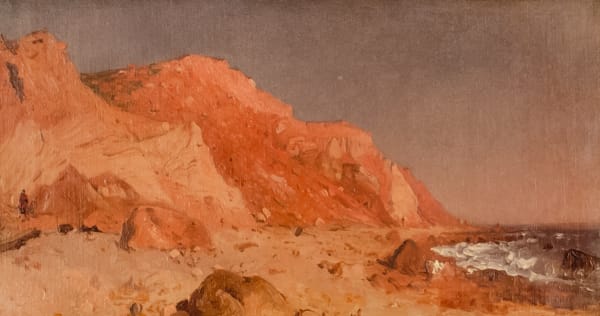Works
Biography
Sanford Gifford was one of the outstanding members of the 19th-century landscape movement in American art. Following on the heels of the early Hudson River artists, Thomas Doughty, Asher B. Durand, and Thomas Cole, a second-generation of artists including Gifford, John Kensett, and Martin Johnson Heade developed their styles into a landscape of mood and serenity, now known as luminism.
Gifford was born in Greenfield, Saratoga County, New York, the son of a wealthy industrialist. Gifford grew up in Hudson, New York, across the river from the Catskill home of his idol, Thomas Cole. The artist attended Brown University for two years but, soon after leaving the school, decided to devote his full attention to art.
In 1845, Gifford went to New York City to study with John Rubens Smith, an accomplished drawing master and author of "A Key to the Art of Drawing the Human Figure (183l)." Gifford studied drawing, perspective and anatomy with Smith, supplemented by drawing from casts and from life at the National Academy of Design. Up to this time, his training was in figural work but, after a sketching trip to the Catskills and the Berkshires in 1846, he gave up the figure completely for landscape. The direction he took was decidedly out of step with the predominant tradition. Unlike Cole, Gifford intended to paint landscapes without the aid of heroic or religious subjects or of transplanted European affectations.
Gifford worked in the New York area until 1855, when he left for Europe to travel and study for three years. In England, he was exposed to the work of J.M.W. Turner and the art criticism of John Ruskin; in Italy he traveled with the American painter Albert Bierstadt; in France he frequented the Louvre and saw the paintings of the French Barbizon School.
The artist returned to America in 1858, taking a studio in the Tenth Street Building where he associated with fellow-tenants Frederick E. Church, Worthington Whittredge, Albert Bierstadt, John Casilear, and others.
Gifford began to create works in his mature style, known today as Luminism. Working slowly and on a small scale, he balanced minute detail with a graceful sense of overall atmosphere. Brushwork is subdued; forms are clearly delineated; topography is sacrificed to the main focus -- the play of light. His statement that "landscape-painting is air-painting" shows his concentration on the subtleties of colored light."
Gifford continued to travel. In 1868 he went abroad again--this time traveling not only in Europe but in parts of the Middle East. The following year, he journeyed with the painters Worthington Whittredge and John Kensett to the Colorado Rockies, where he joined F. V. Hayden's surveying expedition to Wyoming.
Sanford Gifford died in New York City in 1880 at the age of fifty-seven. He was immediately honored by a memorial exhibition at the Metropolitan Museum of Art.
Gifford was born in Greenfield, Saratoga County, New York, the son of a wealthy industrialist. Gifford grew up in Hudson, New York, across the river from the Catskill home of his idol, Thomas Cole. The artist attended Brown University for two years but, soon after leaving the school, decided to devote his full attention to art.
In 1845, Gifford went to New York City to study with John Rubens Smith, an accomplished drawing master and author of "A Key to the Art of Drawing the Human Figure (183l)." Gifford studied drawing, perspective and anatomy with Smith, supplemented by drawing from casts and from life at the National Academy of Design. Up to this time, his training was in figural work but, after a sketching trip to the Catskills and the Berkshires in 1846, he gave up the figure completely for landscape. The direction he took was decidedly out of step with the predominant tradition. Unlike Cole, Gifford intended to paint landscapes without the aid of heroic or religious subjects or of transplanted European affectations.
Gifford worked in the New York area until 1855, when he left for Europe to travel and study for three years. In England, he was exposed to the work of J.M.W. Turner and the art criticism of John Ruskin; in Italy he traveled with the American painter Albert Bierstadt; in France he frequented the Louvre and saw the paintings of the French Barbizon School.
The artist returned to America in 1858, taking a studio in the Tenth Street Building where he associated with fellow-tenants Frederick E. Church, Worthington Whittredge, Albert Bierstadt, John Casilear, and others.
Gifford began to create works in his mature style, known today as Luminism. Working slowly and on a small scale, he balanced minute detail with a graceful sense of overall atmosphere. Brushwork is subdued; forms are clearly delineated; topography is sacrificed to the main focus -- the play of light. His statement that "landscape-painting is air-painting" shows his concentration on the subtleties of colored light."
Gifford continued to travel. In 1868 he went abroad again--this time traveling not only in Europe but in parts of the Middle East. The following year, he journeyed with the painters Worthington Whittredge and John Kensett to the Colorado Rockies, where he joined F. V. Hayden's surveying expedition to Wyoming.
Sanford Gifford died in New York City in 1880 at the age of fifty-seven. He was immediately honored by a memorial exhibition at the Metropolitan Museum of Art.
Exhibitions
Publications
Events
Enquire




